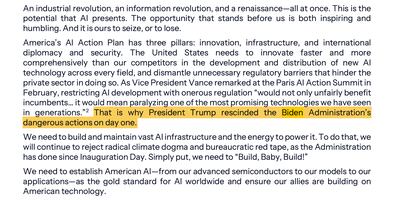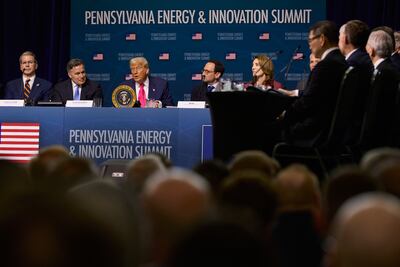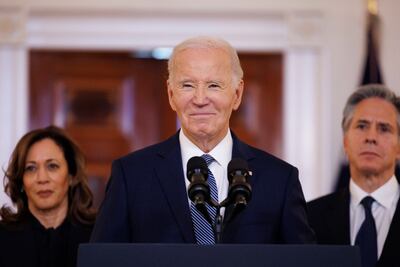President Donald Trump on Wednesday unveiled a three-pillared strategy that his administration refers to as America's AI Action Plan, after much anticipation from US technology companies.
Accelerating artificial intelligence innovation, building AI infrastructure in the US and leading in AI diplomacy are the strategy's three main sections.

Like many of Mr Trump's initiatives, his proposal seeks to portray former president Joe Biden's AI strategy as burdensome from a regulatory perspective and full of identity politics and environmental red tape.
President Trump's plan directs the National Institute of Standards and Technology to “revise the AI management framework, eliminating references to diversity, equity and inclusion, misinformation and climate change”.
The AI push also looks at issues many experts consider more pertinent to the global AI race. It seeks to streamline the construction permit process for data centres, which are becoming critical to AI breakthroughs.

The plan also emphasises exporting “American AI technologies through full-stack deployment packages and international data centre initiatives led by the Department of Commerce”.
That sort of data centre deal is similar to what was unveiled during President Trump's visit to the UAE in May. Then, President Sheikh Mohamed and Mr Trump announced plans for a new 5GW UAE-US AI Campus in Abu Dhabi.
If more of those deals come to fruition, it could help the US gain influence as other countries seek to join the race to provide computational power for AI.
Hypothetically, it could also give the US a competitive edge over China, which also aims to be a dominant AI player.
With his AI Action Plan, Mr Trump is attempting to put the kibosh on local regulatory efforts within the US. State legislative bodies have passed laws to put guardrails on AI in an effort to protect workers from labour disruption.
“Prohibit federal AI funds from going to states with restrictive AI regulations,” reads one of the plan descriptions, also insisting that such prohibitive policies “respect states' legislative rights”.
On a technical level, proponents of open-source AI development are likely to take a victory lap after Mr Trump's plan. It throws support behind open-source and open-weight AI models.
Supporters of open-source AI models often say they democratise artificial intelligence, whereas closed-source models only allow for those with access to larger computing infrastructures to develop the technology.
Neil Chilson, former chief technologist for the Federal Trade Commission and currently head of artificial intelligence policy at the Abundance Institute, called the AI plan a “course correction” from the previous policies of the Biden White House.
“We're particularly excited to see the emphasis on removing regulatory barriers to AI adoption and deployment and streamlining of infrastructure permitting,” he said.
Over at the Competitive Enterprise Institute think tank, reaction to President Trump’s plan was more tepid, alleging that the AI plan still exerted too much regulatory control.
“The plan's push for international AI standards is similar to the European Union’s stultifying regulatory harmonization, which, among other things, is locking the continent into USB-C technology for years to come, even as better technologies emerge,” said Ryan Young, Senior Economist with the Competitive Enterprise Institute.
According to White House officials, President Trump is pushing 90 federal policy actions in the plan, which comes after he sought public input for a comprehensive AI policy in February.
Tech companies, academics and advocacy groups submitted ideas.
Trump officials said the White House received more than 10,000 responses to the requests for guidance, from which it moulded the AI plan.

Consumer rights, labour and environmental groups outlined areas of concern within Mr Trump's less restrictive stance on AI.
Several organisations, such as the Electronic Frontier Foundation, were concerned the tech industry would have too much influence in crafting the AI plan.
“While current machine-learning technologies have some positive applications, they are also being adopted in consequential decision-making contexts where these emerging technologies are likely to cause harm and unlikely to deliver the promised benefits,” the EFF wrote in a March letter to the White House.
During a conference call with reporters, the White House disagreed with the narrative that tech firms had amassed more influence.
“It was probably one of the most diverse set of individuals from across the country and across different sectors, from civil society to Hollywood to academia to the private sector,” a White House official said.
Kit Walsh, director of AI at EFF, said that the White House's AI plan's attempt to curtail diversity, equity and inclusion, among other items, was problematic, and could mean that AI chatbots might "prioritize this administration's own ideological viewpoints over accuracy."
Early in Mr Trump's second term, he signed an executive order that rescinded Mr Biden's executive order on AI.
That order acknowledged the tremendous potential upside of AI and encouraged the acceleration of vital AI standards, but was also geared towards implementing guardrails to protect consumers.
“Developers of the most powerful AI systems [must] share their safety test results and other critical information with the US government,” a portion of Mr Biden's executive order read. That policy is largely absent from President Trump's plan.

